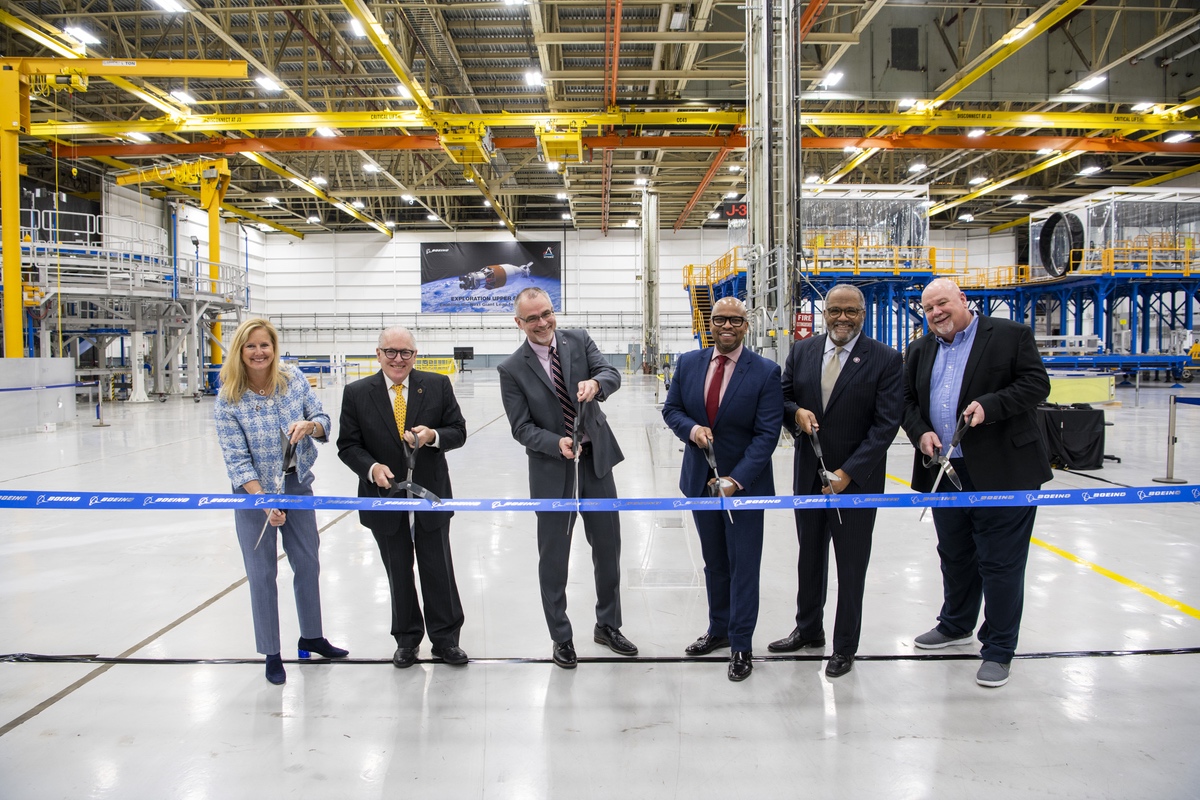WASHINGTON — Boeing has opened the production facility where it will build a new upper stage for an upgraded version of the Space Launch System.
The company held a ribbon-cutting ceremony Feb. 13 at the Michoud Assembly Facility in New Orleans for what it calls the Exploration Upper Stage (EUS) Gray Box, a portion of the sprawling building there where the company will build that upper stage.
The “Gray Box” name comes from a previous use of that part of the building, said John Shannon, mission area vice president for Boeing Exploration Systems, in an interview after the event. Lockheed Martin used that area to produce liquid natural gas tanks, cordoned off from the rest of the facility with dark gray walls and curtains to keep dust from that work from getting into other parts of the building. “It just got the nickname the Gray Box.”
The renovated Gray Box facility, now a pristine white, is home to equipment that will be used to manufacture the EUS. That stage will be used on the Block 1B version of the SLS that will enter service with the Artemis 4 mission in the latter part of the decade.
After completing welding tests, Boeing will produce an EUS structural test article that will then be tested at the Marshall Space Flight Center. Steve Snell, Boeing EUS program manager, said that structural test article should be done in the first half of 2024.
That will be followed by the first flight version of the EUS, which will undergo static-fire tests at the Stennis Space Center like the Green Run test performed on the first SLS core stage. Those tests will use versions of the Aerojet Rocketdyne RL10 engine designed to operate at sea level.
At least two firings of the stage are planned. “It’s to demonstrate that we can restart the engine after it’s been fired,” Snell said. The second firing would take place the same day.
The opening of the EUS Gray Box is part of broader changes that Boeing is making in the production of the SLS core stage and upper stage. In December, NASA and Boeing announced they should shift some core stage assembly work from Michoud to the Kennedy Space Center, taking advantage of underutilized KSC properties like the Space Station Processing Facility and one bay of the Vehicle Assembly Building.
Those changes, Shannon said, were driven by a NASA request to be able to produce two SLS core stages and Exploration Upper Stages a year. “To do two a year, we just couldn’t do it in the footprint that we had,” he said. Moving some work to KSC, such as outfitting of the engine module and integrating it with the rest of the core stage, freed up space in Michoud for increased core stage production. “We reran our factory model and we could get to two a year.”
Those changes will take effect with the SLS being built for Artemis 3, with the engine section for that vehicle shipped to KSC in December. At the time of the ribbon-cutting ceremony workers were preparing to install the engine section onto the core stage for the Artemis 2 SLS, which is scheduled to be completed in May.
NASA’s current plans call for using only one SLS a year through at least the end of the decade. Shannon, though, said there is interest from others in the heavy-lift rocket. “Since Artemis 1 we’ve gotten a lot of interest from a lot of different places,” he said, such as unnamed “other government agencies” interested its payload performance.
However, he said he expected SLS, regardless of the customer, to be used for missions beyond Earth orbit. “It’s really a deep space vehicle. I would never compete SLS for a low Earth orbit activity.”
Among those looking forward to the EUS is NASA astronaut Stan Love. Speaking at the EUS Gray Box ceremony, he said the astronaut office appreciated the fact that the EUS was designed from the beginning to be human rated and not have that human rating “stapled on” as is the case with the Interim Cryogenic Propulsion Stage, the upper stage based on the one built for the Delta 4 that used on the current Block 1 version of the SLS.
That includes more control of the stage during flight, particularly in abort scenarios. “We’re really looking forward to EUS,” he said. “A lot of capability in there and safety is built it. It’s part of the way we like to operate spacecraft, which is not to be a dumb payload sitting on top.”
